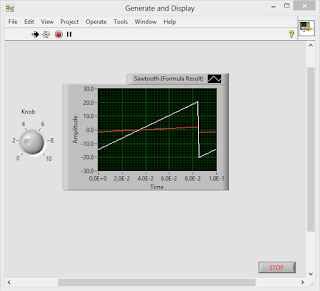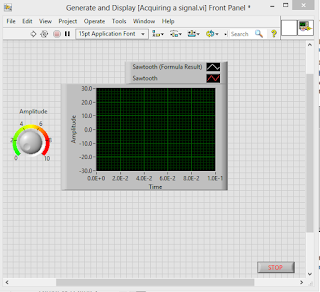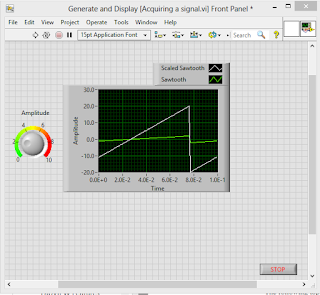1. Launch Lab View
Next is OPENING A NEW VI FROM THE TEMPLATE
File >> New >> VI
Select General and Display >> OK
Front Panel and Block Diagram will appear like pic below
At the Front Panel, click the Run button and the sine wave will appear at the front panel. The wave is running and while to stop it just click the Stop button.
Now we want to ADD A CONTROL TO THE FRONT PANEL
At the Front Panel click View >> Control Palette
control palette will appear like this
At the Control Palette,
Choose Express >> Numeric Control >> Knob
So move the knob here to the Front Panel next to the waveform graph.
Like this
so after finish we can save the project that we have create above. Just click save as, and select destination.
Next......
CHANGING A SIGNAL TYPE
On
the Block Diagram, right click Simulate Signal >> Properties >> Signal
Type >> Saw Tooth >> OK
Next we move to the block diagram, Move the cursor over the down arrows
at the bottom of the Simulate Signal Express VI, click and drag the border of
the Express VI to add two rows. When we release the border, the Amplitude box input appears.
WIRING OBJECT ON THE BLOCK DIAGRAM
Okay now we move to how to make wiring on the block diagram..
Move the cursor over the arrow on the Knob terminal. The cursor becomes a wire spool. When the Wiring tool
appears, click the arrow on the Knob terminal
and then click the arrow on the Amplitude input
of the Simulate Signal Express VI, to wire up the two objects together.
RUNNING A VI
Front
panel >> Run >> move the cursor at the knob ( where the cursor will become a hand or the name is Operating Tool that will be shown at the left ). Use the Operating tool to change the value of the control.
MODIFYING A SIGNAL
Go to Block diagram >> click the wire that connect the Simulate Signal Express VI to the Waveform Graph terminal >> delete key
Next, right click to open the function palette
Function palette >>Express >> Arithmetic &
Comparison >> drag to block diagram between Simulate
Signal Express VI and the Waveform
Graph terminal
Configure formula dialog >> help
Change
the text in the Label column of
the dialog box option you read about, from X1 to Sawtooth. When you
click in the Formula text
box at the top of the Configure Formula dialog box, the text changes to match the label you entered.
entering
*10 after Sawtooth in the Formula text
box >> OK
Click
output of the Simulate Signal Express VI, When the Wiring tool appears, click
the arrow on the Sawtooth output
and then click the arrow on the Sawtooth input of the Formula Express VI
to wire the two objects together.
Use
the Wiring tool to wire the Result output of the Formula Express VI to the Waveform Graph terminal >> Save
DISPLAYING TWO SIGNALS ON A GRAPH
So from this task we go to the block diagram, move the cursor over the arrow on the Sawtooth
output
of the Simulate Signal Express VI. Next, Use the Wiring tool to wire the Sawtooth output to the Waveform
Graph terminal.
and then File >> Save
Return
to the front panel, run the VI, and turn the knob control. The
graph plots the original sawtooth wave and the scaled sawtooth wave
with 10 times the amplitude, as we specified in the Formula
Express
VI. The maximum value on the y-axis automatically scales as you
turn the knob.
At
knob 2 graph display original and scaled
sawtooth wave within ten which is 20 as 2 x 10 = 20. Click the STOP button to
stop the VI.
CUSTOMIZING A KNOB CONTROL
Right-click the front panel knob and select Properties
from the shortcut
menu to display the Knob Properties dialog box. Click the Appearance tab to display the Appearance page. In the Label section on
the Appearance page,
delete the label Knob, and
enter Amplitude in the text box.
Click
the Scale tab. In the
Scale Style section,
place a checkmark in the Show color ramp checkbox.
The
knob in the front panel window updates to reflect these changes. Click the OK button to
save the current configuration and close the Knob Properties dialog box. Save the VI.
CUSTOMIZING A WAVEFORM GRAPH
In the front panel window, move the cursor over the top of the plot legend
on the waveform graph.
Though
the graph has two plots, the plot legend displays only one plot. When a double-headed arrow appears, shown in Figure 1-11, click and drag
the border of the plot legend to add one item to the legend. When you
release the mouse button, the second plot name appears.
Right-click the waveform graph and select Properties
from the shortcut
menu to display the Graph Properties dialog box. On the Plots page,
select Sawtooth from
the top pull-down menu. In the Colors section, click the Line color box to display the color picker. Select a new line color

Select Sawtooth (Formula Result) from the top pull-down menu. Place a checkmark in the Do not use waveform names
for plot names checkbox.
This action lets you edit the labels on the graph.

In the Name text box,
delete the current label and change the name of this
plot to Scaled Sawtooth.
Click the OK button to
save the current configuration and close the Graph Properties dialog box
Right-click the waveform graph and select Properties
from the shortcut
menu to display the Graph Properties dialog box. On the Plots page,
select Sawtooth from
the top pull-down menu. In the Colors section, click the Line color box to display the color picker. Select
a new line color.































No comments:
Post a Comment